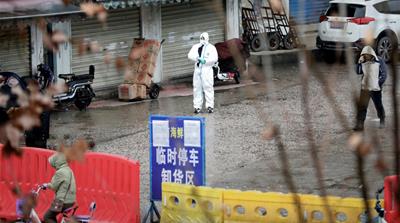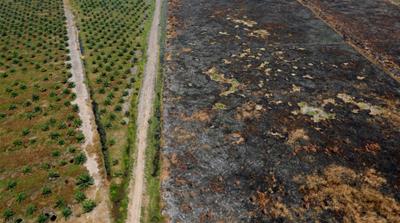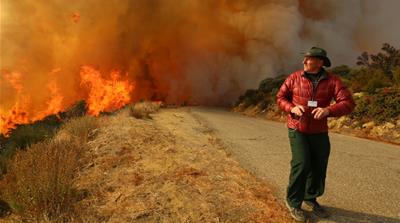Could coronavirus save the planet by changing economics forever?

Kuala Lumpur, Malaysia – While working from my home on the outskirts of the Malaysian capital, Kuala Lumpur, a month ago, focused on the unfolding crash in world financial markets and economies due to the coronavirus pandemic, I saw one of two 50-foot palm trees in the garden also come crashing down.
The tree had been planted by the previous owners of the house, possibly around 30 years ago. On closer inspection, it became clear that its roots had simply outgrown the soil under them.
Wednesday sees the world mark the 50th annual Earth Day, a call by concerned citizens and activists for leaders to take decisive action against climate change. But this year’s events will all be held online, as most of the planet struggles with the expanding coronavirus crisis and its effects on the global economy.
Much has been written about how the pandemic is crushing manufacturing supply chains and the demand for goods and services, while putting millions of people out of work.
But relatively little has been said about how economic activity may have contributed to the outbreak in the first place.
The fallen tree could be seen as something of a metaphor for a global economic system that is rapidly reaching the Earth’s environmental limits.
Every economic crisis has its fair share of Cassandras predicting the imminent demise of capitalism as we know it.
But there is now a growing number of eminent scientists and economists arguing that our current methods of measuring the size and growth rate of the economy are deeply flawed, leading us to produce more goods and services than the Earth’s resources can sustain.
In fact, these economists and scientists have been warning the world for years about the likely consequences of breaching those barriers.
One of those outcomes, they argue, is the possibility of frequent, and ever more ferocious, outbreaks of infectious diseases as commercial interests push humanity into closer contact with natural habitats that are reservoirs of pathogens like the SARS-CoV-2 virus that leads to COVID-19.
The current, most widely held theory of the origins of the outbreak is that it started in a seafood and wildlife market in the central Chinese city of Wuhan late last year.
The quest for growth
But the researchers and thinkers warning about such events are not part of mainstream economics, with its unrelenting quest for growth in gross domestic product (GDP) – the sum value of all finished goods and services generated in a country, and the most commonly used indicator of economic health.

There is little doubt that the concept of economic growth has helped pull billions of people out of poverty over the last 70 years or so.
But now, its shortcomings are coming into stark relief. Researchers are questioning contemporary economics’ most fundamental assumptions, including whether growth can, or indeed should, continue forever.
“More planetary crises are coming,” members of The Club of Rome, a group of politicians, economists and scientists, said in a statement last month.
“If we muddle through each new crisis while maintaining the same economic model that got us here, future shocks will eventually exceed the capacity of governments, financial institutions, and corporate crisis managers to respond. Indeed, the ‘coronacrisis’ has already done so.”
One of the problems with using GDP growth as a yardstick for our economic wellbeing is that it fails to take into account the costs to the environment of manufacturing, travelling and everything else we have taken for granted in our modern, consumerist lifestyles – until the pandemic struck, of course.
Nature’s services
Some economists have made estimates of the value of the “services” the natural environment provides us.
Trees and other plants that pull carbon dioxide out of the air, thereby helping to reduce the effects of global warming; the savings a factory enjoys by dumping its waste into an adjacent river, rather than dealing with it in ways that are less harmful to communities living downstream; the value of retaining tree roots that prevent soil erosion – these are just some examples of ecological services that standard economic measurements do not take into account.

And the value of such natural services is astounding.
Pavan Sukhdev, an economist and president of the board of conservation group World Wildlife Fund International, published a landmark paper in 2008 estimating that the annual loss of such ecosystem services to humanity over a 50-year period, due to deforestation, amounts to an estimated $2 trillion to $4.5 trillion each year.
That amounts to between two percent and five percent of the world’s total annual GDP in 2018.
Sukhdev won the Tyler Prize for Environmental Achievement – regarded by many as the Nobel Prize for ecological conservation – earlier this year for his work on the relationship between the environment and economics.
The destruction of forests and wetlands or the damage caused by damming rivers should be considered costs to the economy, says Sukhdev. But on the contrary, activities such as these are added into national accounts, boosting GDP.
That in turn gives policymakers who want faster economic growth rates an incentive to encourage industrial activities regardless of their environmental impact.
And those policies could now be having a direct impact on our health.
Hidden costs
In another paper published in 2008, Kate Jones, professor of ecology and biodiversity at University College London, says that her team’s research “supports previous hypotheses that disease emergence is largely a product of anthropogenic and demographic changes, and is a hidden ‘cost’ of human economic development”.
Today, such warnings are mostly being drowned out by those trying to predict whether the trillions of dollars being pumped by central banks and governments into their economies to prevent them from falling into a deep recession – most commonly defined as at least two consecutive quarters of economic contraction – will be enough to restore GDP growth to its upward path.
Or by others trying to figure out whether the crash in stock and commodity prices since last month has further to go, or if now is the time for investors to start buying such assets again on the cheap.
But there is a growing awareness among economists that alternatives to GDP growth need to be seriously considered, not just because of the effect it has on the environment but also because of its impact on social inequality, which has widened to near-historic levels in recent years, and in turn led to a return to the kinds of political polarisation not seen in nearly a century.
So what are the possible alternatives to GDP?
Some such indicators have been around for many years. For example, the Index of Social Health, invented by the United States-based Institute for Innovation in Social Policy and published annually from the 1970s until 2011, measured parameters such as infant mortality, child abuse, unemployment and health insurance coverage amongst others.
More recently, the United Nations Environment Programme (UNEP) launched its Inclusive Wealth Index in 2012. It measures three main parameters: produced capital, or manufactured goods and services; human capital, which includes the value of education and health; and natural capital, or the value of natural services.
In its latest biennial report, the UNEP said that while global GDP had grown by an average of 3.4 percent a year between 1990 and 2014, inclusive wealth had expanded by just 1.8 percent annually. And of the three key components of inclusive wealth, produced and human capital had grown, but natural capital had shrunk over that period.
Beyond growth
The concept of a world beyond GDP growth has perhaps been best summarised by Kate Raworth, an economist at the University of Oxford’s Environmental Change Institute.

In her book, Doughnut Economics: Seven Ways to Think Like a 21st-Century Economist, Raworth outlines a new economic model in which the global economy, driven by a combination of public, private and cooperative enterprises, ebbs and flows within boundaries. Health, education and social equity form the foundations of her economic model, while the planet’s environmental limits provide the outer boundaries to its growth.
“Twenty-first-Century economists, especially those in today’s high-income countries, now face a challenge that their predecessors did not have to contemplate: to create economies that make us thrive, whether or not they grow,” Raworth writes.
All this might seem utopian to many.
But the measures put in place by governments to control the spread of the coronavirus have most likely already plunged the world into a deep recession. With the prognosis for the global economy still facing question marks, the virus may be forcing us to permanently change the way we measure our collective wealth, whether we like it or not.